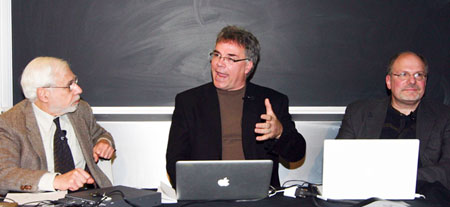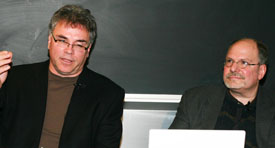| The Culture Beat and New Media: Arts Journalism in the Internet Era | ||
|
Newspapers and magazines are reducing their critical coverage of the arts, but the human appetite to evaluate culture, to debate reactions and opinions, remains as vibrant as ever. Panelists Doug McLennan (editor of ArtsJournal.com) and Bill Marx (editor of TheArtsFuse.com) will discuss how cyberspace is transforming arts journalism, in some cases radically redefining its form and content. The forum will debate what critical values from the traditional media should survive, explore how digital media is changing the ways we articulate our responses to the arts, and point to promising contemporary business models and experiments in cultural coverage. Forum Director David Thorburn will moderate the discussion. An audio recording of The Culture Beat and New Media is now available. A podcast of The Culture Beat and New Media is now available. Video of The Culture Beat and New Media is now available. [this is an edited summary, not a verbatim transcript] Forum Director David Thorburn started the talk by offering a definition of arts criticism: Broadly, it is discourse about the arts – dance, drama, prose fiction, poetry, etc. – in our culture.
William Marx expanded on it by saying criticism also had to provide evaluation backed up by reasoned argument, a point he reiterated throughout the evening.
Thorburn asked both men to describe the state of art criticism prior to the rise of the internet.
Marx started by pointing out that arts criticism played a pivotal role in many newspapers and magazines starting in the early nineteenth century. It helped define the developing American culture and send people to or away from specific works or performances. Because there were no editorial standards in place it was also corrupt. In the 1830s and 1840s, for example, when a book went out for review it would often include a five dollar bill – quite a bit of money at that point.
According to Marx, this started to change in the late nineteenth century as newspapers and magazines reached an increasingly sophisticated audience and reviewers were expected to have a degree of knowledge about the topics on which they were writing.
In the world of high culture, Marx continued, there were fixed ideas on what made a great symphony or a great painting. With the rise of more popular art forms – jazz, radio and films – the ideas of evaluation and judgment became less fixed and this changed the nature of arts criticism.
Doug McLennan joined the conversation to debunk the idea of a past Golden Age of arts criticism where newspapers had full arts staffs engaged in criticism as an evaluative process. The reality, he said, was that most newspapers didn't have arts editors or critical staffs. This didn't become standard until the 1970s and 1980s. The fact that newspapers are again without these resources is a return to what had been typical for most of the history of arts criticism in the United States.
Building on this topic, Thorburn asked about the function of newspapers, particularly in the twentieth century, as a source of advice for cultural consumers. Many reviews ceased to be reasoned evaluations and became simply descriptive, he said. Critical evaluation forms only a part of arts coverage in the popular press where feature stories on actors or directors or new projects dominate.
Picking up the point, Marx said that during the 1970s and 1980s, there was an attempt to meld criticism into more general arts coverage. He cited as an example Tina Brown's desire for “feature reviews” during the 1990s in the New Yorker that included interviews with the writers, directors and performers of the productions being reviewed. This trend, he said, downplayed the importance of the evaluative aspect of the review.
McLennan suggested that the whole movement toward melding was a reaction to the thumbs-up or thumbs-down reviews in the popular press. People wanted more than the simple Consumer Reports-style recommendations.
Marx agreed but felt that the Tina Brown approach was still essentially about thumbs. He said he hadn't read any “feature reviews” from the New Yorker during Brown's tenure that were negative or even mixed. If an arts reporter interviews the cast or director they are unlikely to pan the production, he said. In this style of review, the thumb is always up.
Thorburn observed that while there might be a revolution going on in arts criticism it is going to be a long one – with the elements of print culture migrating online over the course of years or even decades. There will also be ongoing overlaps between print and online culture, he said, and he asked the speakers to share their thoughts on the continuity of criticism and how the internet might change things.
McLennan pointed out that there are things the traditional media has not covered well – dance, community arts, etc. – while more than 300,000 arts blogs are now engaging in conversations about the arts. He believes that the revolution mentioned by Thorburn isn't limited to the arts or to the transition from print to online, but also has to do with how art is being made and used. According to McLennan, we're moving away from the broadcast model in both arts and arts criticism to one that is more interactive. And because people have access to more options and opportunities, the conversation is changing.
McLennan went on to say that younger people aren't going online to find information; they are going online to engage in community. They tend not to trust those media with closed editorial systems or established experts. They trust those things they can engage in and more young people are engaging in making art online. If the ways people are approaching culture is changing, he continued, then the journalism covering culture needs to change as well.
Marx agreed that we're in a period of transition and the way people articulate their reaction to art is also changing. It's through the process of interaction, he said, that people learn to articulate their critical evaluations. This articulation, he believes, if learned successfully online, can become part of the wider critical culture – but it hinges on people being able to provide reasons for their evaluation.
Thorburn pointed to reader forums – such as those available through the New York Times – that generate commentary on traditional media content as examples of where critics and readers connect. Another example he cited was Robert Pinsky's poetry column on Slate which provides an opportunity for professional poets and fans of poetry to engage around specific works in ways that have enlarged the discourse and invigorated the art.
Thorburn then pointed to reviews on the Amazon website where one can tell, he said, which reviews are substantive and which are fluff. It's through understanding these reviews that one develops their own critical standards, he said.
Marx agreed – to a degree – but raised the issue of reviewer ethics. On Amazon, he continued, there are many articulate and perhaps well-reasoned reviews that are written by shills.
Thorburn asked whether this kind of abuse on the web was worse than in the past, pointing out that corruption in the reviews process was rampant in the past with literary giants like James Joyce engaging in underhanded practices.
Marx felt that things were – if anything – perhaps better now. Certainly in the past planted reviews occurred – Edgar Allen Poe frequently did this – but at least today critics aren't being attacked or killed as was sometimes the case in the nineteenth century.
Thorburn asked Marx and McLennan to describe examples of good arts criticism on the web.
McLennan pointed out that there are lots of new sites with people trying new things; but none have figured out the right model. Some are facing issues of content quality, while others are focusing on the arts in a specific place but blur the line between criticism and documentary. And, there are sites like Glasstire which are doing real criticism and doing it well, he said.
Marx believes technology and experimentation will be an important part of criticism in the future. Mixing words and images needs to happen, he said, and is a challenge that should be taken up by people interested in criticism. While he hopes people will reinvent the arts review through technology – they need to keep evaluation and reason in mind.
Q&A
QUESTION: You offer a perspective on the internet that I don't see; are we looking at the same internet? You're also into expertise and curation. And there's an assumption – on your part – that we're going to see the experts rise again. I have a hard time understanding why we'd want that to happen – shouldn't we all try to educate ourselves and be a part of the conversation?
MARX: All of these things we've discussed are tools for education. Hopefully you will gravitate to the people whose views and opinions you value. I'm excited by what's happening, but it would be good to move beyond the Siskel and Ebert model.
McLENNAN: I agree 100 percent. I don't see a return to the expert. There's a nichification of culture. The bland middle mass culture isn't going to be sustainable. Some of the most interesting people I'm reading are doing what they love and have become experts in the thing they are doing. The challenge is finding curators that you trust.
There are so many interesting models – reviews of graphic novels in the format of graphic novels, music in response to music, movement in response to movement. These things are often very ephemeral. But there's also the whole movement of response videos that offer an amazing example of what can be done.
QUESTION: How do you see the evaluation process changing as criticism moves online?
MARX: This is a pivotal issue – it's what's being discovered right now. Read some of the critics of the past to find what you might be able to use and what you need to create that doesn't exist. Consider the addition of video to support or supplement language. But if we're talking about evaluation – we need to think and know what our options are – but we haven't seen enough examples thus far.
| ||




